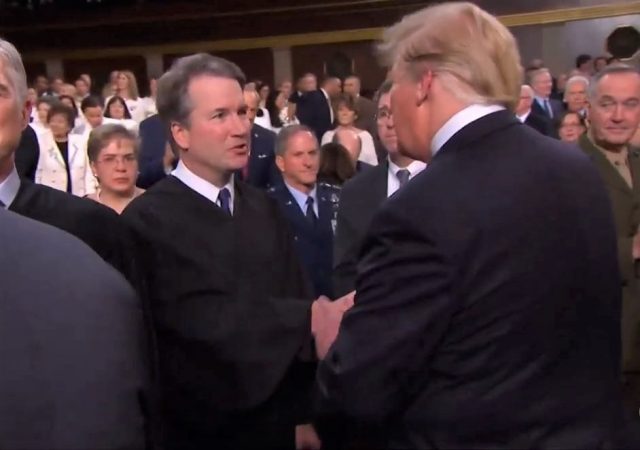While you were distracted by [insert news cycle], Trump continued to reshape the federal judiciary

The Trump judicial confirmation train kept rolling down the tracks the past few weeks, as you probably were distracted by the news cycle frenzy of the day.
Trump has the opportunity to reshape the federal judiciary at every level.
This is a theme I’ve writing about since before Trump was inaugurated, Dems’ Nuclear Option will allow Trump to fill over 100 court vacancies quickly (December 26, 2016), and Liberal nightmare: Trump could appoint half federal judiciary (January 18, 2017).
I’ve also focused on how the furious news cycles have distracted just about everyone from Trump’s judicial progress, While you were focused on COMEY, Trump nominated another group of CONSERVATIVE Judges and Republicans continue reshaping federal judiciary, though you probably are focused on Democrat anti-Semitism.
Do you know where things stand now? Of course not, you’ve been focused on Democrat histrionics about Mueller and Barr and just about everything else.
Where does it stand now, over two years later? Carrie Severino of the Judicial Crisis Network, provides the statistics as of May 13, 2019:
Last week, the Senate voted to confirm Joseph Bianco and Michael Park — President Trump’s 38th and 39th circuit court judges, respectively — since Inauguration Day. By comparison, only 18 circuit court judges had been confirmed by this point in President Obama’s first term.Also last week, Senate majority leader Mitch McConnell filed for cloture to end debate on the nomination of Ken Lee, one of President Trump’s currently pending nominees to the U.S. Court of Appeals for the Ninth Circuit. The Senate is also expected to vote this week on the confirmations of two district court nominees.[WAJ note: Lee was confirmed]Nominees Confirmed by the Senate since Inauguration Day: 104Supreme Court: 2Courts of Appeals: 39District/Specialty Courts: 63
There are many more vacancies to be filled, particularly at the district court level, via Severino:
Current and known future vacancies: 158Courts of Appeals: 8District/Specialty Courts*: 150Pending nominees for current and known future vacancies: 57Courts of Appeals: 3
District/Specialty Courts*: 54
Looking at these numbers, it’s clear that Trump and Senate leadership focused on Courts of Appeal. From a strategic point of view, that makes sense. Because the Supreme Court takes so few cases, Courts of Appeal serve as the court of last resort in the vast majority of cases. Trump is just a few appeals court judges away from taking over (if you want to call it that), the liberal bastion of the 9th Circuit (emphasis added):
The Senate confirmed President Trump’s nomination of attorney Kenneth Lee to the federal appeals court based in San Francisco on a party-line vote Wednesday, over Democratic objections to Lee’s college writings that disparaged minorities and women.The 52-45 vote makes Lee the fifth Trump appointee on the Ninth Circuit Court of Appeals, which the president has regularly vilified as hostile and biased for its rulings against him on issues such as immigration and birth control and his ban on travel from a group of mostly Muslim nations. The Ninth Circuit now has 16 judges appointed by Democratic presidents, 10 by Republicans and three vacancies.By increasing the likelihood of conservative voices on the three-judge panels that decide most of the court’s cases, “I think (Trump’s appointments) will begin to make a difference,” said Carl Tobias, a University of Richmond law professor who tracks judicial selections.
If you think conservatives are resting on their laurels, think again. The NY Times reports that conservatives are shifting into higher gear, Conservative Group Wants to Bring ‘Brass Knuckles’ Approach to Judicial Fray:
In the latest escalation of partisanship surrounding federal judicial nominations, an advocacy group is being created on the right to maintain momentum behind the Republican judicial juggernaut and prepare for the inevitable next Supreme Court fight.
Named the Article III Project for the section of the Constitution that established the judiciary, the organization will be led by Mike Davis, a former Republican Senate and White House aide who was a central figure in the confirmations of Justices Neil M. Gorsuch and Brett M. Kavanaugh.
Mr. Davis, 41, is known as a take-no-prisoners conservative eager to challenge the left with hardball tactics. He now intends to apply those techniques to judicial confirmations from the outside after his inside work on behalf of Justices Gorsuch and Kavanaugh and scores of federal judicial nominees seated on the bench since the start of the Trump administration.
“What I want to do with the Article III Project is take off the gloves, put on the brass knuckles and fight back,” said Mr. Davis, an Iowa native who was the chief nominations counsel for Senator Charles E. Grassley, an Iowa Republican who was the chairman of the Judiciary Committee until this year.
On top of that, Republicans see judicial nominations as a key to 2020 victory, as it was in 2016. Politico reports, Trump team convinced court overhaul will drive 2020 win:
The White House is rushing to appoint as many judges as possible before 2020 to give President Donald Trump yet another talking point he can rally on as he stumps for re-election.Trump’s team believes that stacking the judicial system with conservative judges galvanizes the base, demonstrates his ability to follow through on a 2016 campaign promise and will help win over crucial 2020 states like Colorado, Florida and North Carolina. And Trump himself is convinced that judicial appointments are central to both his legacy and policy agenda, as he has pushed for young judges who can serve for decades, according to former administration aides, close White House advisers and those familiar with the administration’s judicial plans.
So while #TheResistance fights for impeachment and other impossible dreams, Trump is changing the judiciary in a way that goes beyond the news cycle or even his presidency.
CLICK HERE FOR FULL VERSION OF THIS STORY